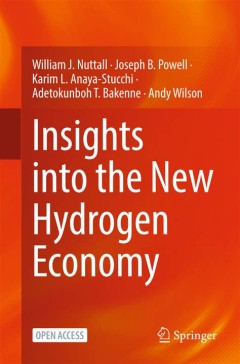Filter by

Portfolioarbeit in der Grundschule = Ein Lernwerkzeug im Spannungsfeld zwisch…
Dieses Open-AccesBuch thematisiert Portfolioarbeit in einer inklusionsorientierten Grundschule im Rahmen der luxemburgischen Bildungsreform und unter besonderer Berücksichtigung der komplexen Mehrsprachigkeitssituation des Großherzogtums. Das Portfolio wurde als wichtiges Instrument zur Implementierung eines Kompetenzmodells und einer neuen Leistungsbeurteilung angedacht und sollte nicht nur…
- Edition
- 1
- ISBN/ISSN
- 9783658464066
- Collation
- XXVII, 465 hlm; ill., lamp.,
- Series Title
- -
- Call Number
- -

Technological Utopianism and the Idea of Justice
This open access book advances a modest defence of technological utopias. While technological utopianism is not devoid of risks and elitism, their benefits should not be discounted in an overall assessment. Rather than rejecting them based on a too narrow definition of utopianism, we must acknowledge their potential to exceed the individualist vs. collectivist dichotomy ascribed to traditional …
- Edition
- 1
- ISBN/ISSN
- 9783031759451
- Collation
- IX, 156 hlm; ill., lamp.,
- Series Title
- -
- Call Number
- -

The Platformization of the Family = Towards a Research Agenda
This open access book outlines how the digital platforms that mediate so many aspects of commercial and personal life have begun to transform everyday family existence. It presents theory and research methods to enable students and scholars to investigate the changes that platformization has brought to the routines and interactions of family life including intergenerational communication, inter…
- Edition
- 1
- ISBN/ISSN
- 9783031748813
- Collation
- XI, 113 hlm; ill., lamp.,
- Series Title
- -
- Call Number
- -

Secularization and China's Modernization
This open access book examines from the perspective of secularization. Since the publication of Max Weber's Protestant Ethics and the Spirit of Capitalism, how to realize modernization in developing countries has become an urgent problem to be demonstrated. Secularization has becoming endogenous power for Chinese modernization procedure, especially since 1978. However, to understand the foundat…
- Edition
- 1
- ISBN/ISSN
- 9789819780624
- Collation
- XI, 402 hlm; ill., lamp.,
- Series Title
- -
- Call Number
- -

Differenzerleben als Balanceakt = Eine Grounded Theory zu medienbezogenen Bil…
In diesem Open-Access-Buch wird der Frage nachgegangen, inwiefern medienbezogene Bildungsprozesse in Paarbeziehungen stattfinden. In der heutigen Informationsgesellschaft stehen Individuen in einer Paarbeziehung vor der Herausforderung, mit digitalen Transformationsprozessen umzugehen. Hierzu liegt eine Vielzahl von Studien vor, die Veränderungen durch Medien im Paaralltag untersuchen. Doch hi…
- Edition
- 1
- ISBN/ISSN
- 9783658460143
- Collation
- XIX, 362hlm; ill., lamp.,
- Series Title
- -
- Call Number
- -

Strengthening European Climate Policy = Governance Recommendations from Innov…
This open-access book foregrounds 10 novel collaborations between the Social Sciences and Humanities (SSH), and Science, Technology, Engineering and Mathematics (STEM) disciplines, for strengthening European climate policy. Part of a three-volume collection covering climate, energy, and mobility policy.
- Edition
- 1
- ISBN/ISSN
- 9783031720550
- Collation
- XXXV, 163 hlm; ill., lamp.,
- Series Title
- -
- Call Number
- -

Insights into the New Hydrogen Economy
This open access book offers a comprehensive exploration of the future of the hydrogen industry. It builds upon insights gathered from a series of expert workshops and follow-on activity. International experts from various fields, including industry, public policy, and academia, engaged in dialogue and knowledge exchange, resulting in invaluable findings and observations. This book builds upon…
- Edition
- 1
- ISBN/ISSN
- 9783031718335
- Collation
- XXIX, 162 hlm; ill., lamp.,
- Series Title
- -
- Call Number
- -

Mastering Your Entrepreneurial Journey = From Vision to Venture
Entrepreneurship is a powerful force for change and innovation; you can be a part of it. This open access book is your key to unlocking your potential as an entrepreneur and impacting the world through your actions. Written by experienced startup guides and backed by rigorous academic research, this book takes you through the essential steps along your entrepreneurial journey. This unique mix …
- Edition
- 1
- ISBN/ISSN
- 9783031710643
- Collation
- XIV, 140 hlm; ill., lamp.,
- Series Title
- -
- Call Number
- -

Re-presenting Research A Guide to Analyzing Popularization Strategies in Sci…
This open access book focuses on the textual features, or ‘strategies’, which form popularization discourse. In popularization discourse, research findings from academia are re-presented to make them noteworthy to society and influential for everyday life. Popularization involves recontextualization, or reimagination of findings in an everyday and newsworthy context, and reformulation, the …
- Edition
- 1
- ISBN/ISSN
- 978-3-031-28174-7
- Collation
- XI, 141
- Series Title
- -
- Call Number
- -

Chairperson Succession :Competences, Moderators, and Disclosure
This open access book empirically analyses the competences (input), moderators (process), and disclosure (output) of board chair succession practices for publicly listed organisations in Switzerland. As primus inter pares (Latin for first among equals), the chair of the board of directors holds a unique organisational position. For fulfilling the non-transferable duties pursuant to Article 716a…
- Edition
- 1
- ISBN/ISSN
- 978-3-658-40817-6
- Collation
- XXI, 261
- Series Title
- -
- Call Number
- -
 Computer Science, Information & General Works
Computer Science, Information & General Works  Philosophy & Psychology
Philosophy & Psychology  Religion
Religion  Social Sciences
Social Sciences  Language
Language  Pure Science
Pure Science  Applied Sciences
Applied Sciences  Art & Recreation
Art & Recreation  Literature
Literature  History & Geography
History & Geography